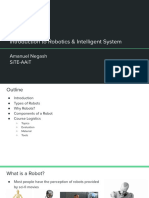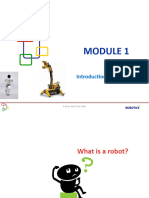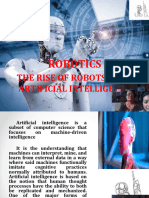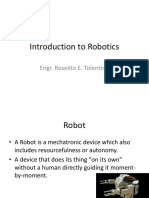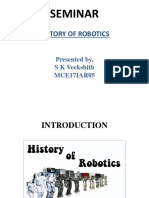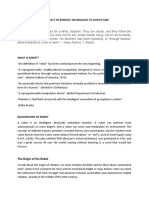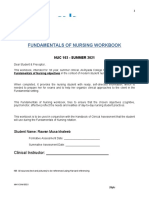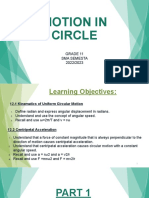Fundamentals of Robotics
Introduction to ROBOTICS
and History
Slides material credit: DRIMS. Slides updated by Dr. Asif Khan Fundamentals of Robotics
�This semester we will study many aspects of robotics.
General Robot Structures
General Definitions
Robot modelling
Robot Actuators and Drive Systems
Sensors
Forward Kinematics
Inverse Kinematics
ROS (Robot Operating Systems)
Practical on different robots from
CRAIB (Center for Robotics Artificial
Intelligence and Blockchain)
2
�Fundamentals of Robotics
3
�4
� A Robot is:
An electromechanical device that is:
– Reprogrammable
– Multifunctional
– Sensible for the environment
• An automatic device that performs functions
normally ascribed to humans, or a machine in the
form of a human.
• Robots are multifunctional, re-programmable,
automatic industrial machines designed for replacing
humans in hazardous work.
5
�What is a Robot: I
Manipulator
6
� What is a Robot: II
Legged Robot Wheeled Robot
7
� What is a Robot: III
Autonomous Underwater Vehicle Unmanned Aerial Vehicle
8
� What Can Robots Do: I
Jobs that are dangerous
for humans
Decontaminating Robot
Cleaning the main circulating pump housing
in the nuclear power plant
9
� What Can Robots Do: II
Repetitive jobs that are
boring, stressful, or labor-
intensive for humans
Welding Robot
10
� What Can Robots Do: III
Manual tasks that human
don’t want to do
The SCRUBMATE Robot
11
� Advantages of Robots
⚫ Can increase productivity, safety, efficiency, accuracy, quality,
and consistency of products
⚫ Can work in hazardous environments such as radiation,
darkness, hot and cold, ocean bottoms, space etc.
⚫ No need of environmental comfort like lighting, air
conditioning, ventilation, and noise protection.
⚫ Can work continuously without tiring or fatigue or boredom,
and need no medical insurance or vacation
⚫ Can perform repetitive jobs that are boring, stressful, or labor-
intensive for humans
12
� Disadvantages of Robots
⚫ Inappropriate or wrong responses
⚫ Lack of decision-making power, Cognition, creativity,
decision-making, and understanding
⚫ Loss of power
⚫ Damage to the robot and other devices
⚫ Limited Degrees of freedom and dexterity, Sensors and vision
systems
⚫ Real-time response
⚫ Initial cost of equipment and installation
⚫ Need for peripherals
⚫ Need for training and programming
13
� Categories of Robots
⚫ Basic categories
⚫ Aerial
⚫ Ground
⚫ Water
⚫ Operational categories
⚫ Autonomous
⚫ Remote Controlled
14
� Types of Robot
⚫ Industrial Robots/Manipulators
⚫ Mobile Robots
⚫ Humanoid robots
⚫ Medical Robots
⚫ Exoskeleton
⚫ Drones
15
� Robots (everywhere)
⚫ Agriculture, Automobile, Construction, Entertainment
⚫ Health care: hospitals, patient care, surgery, research,
etc.
⚫ Laboratories: science, engineering, etc.
⚫ Law enforcement: surveillance, patrol, etc.
⚫ Manufacturing
⚫ Military: demining, surveillance, attack, etc.
⚫ Mining, excavation, and exploration
⚫ Transportation: air, ground, rail, space, etc.
⚫ Warehouses
16
� Robots (in industry)
⚫ In industry mostly manipulators are used for following tasks;
⚫ Material handling
⚫ Material transfer
⚫ Machine loading and/or unloading
⚫ Welding
⚫ Spray coating
⚫ Assembly
⚫ Inspection
17
� Robot & Machine
Machine Robot
Externally Controlled Autonomous
Predetermined functions Programmable
Operated manually Decision making
18
� Criteria for a Robot
⚫ Sense
⚫ Act
⚫ Energy/Power
⚫ Programmable
⚫ Autonomous*
19
� Components of a Robot
⚫ Sensors
⚫ Camera, Touch, Laser scanner etc.
⚫ Controller
⚫ Microcontroller, Arduino, Raspberry Pi etc.
⚫ Software
⚫ Actuators
⚫ End-effectors
⚫ Motors, Valves, Cylinders etc.
20
�Human & a Robot
21
� History of Robotics - The Origins of Robots
≈250 B.C. - Ctesibius, an ancient Greek engineer and
mathematician, invented a water clock which was the most
accurate for nearly 2000 years.
≈60 A.D. – Hero of Alexandria designs the first automated
programmable machine. These 'Automata' were made from a
container of gradually releasing sand connected to a spindle via
a string. By using different configurations of these pulleys, it was
possible to repeatably move a statue on a pre-defined path.
22
� History of Robotics - The Origins of Robots
≈ 1250 - Bishop Albertus Magnus holds
banquet at which guests were served by metal
attendants. Upon seeing this, Saint Thomas
Aquinas smashed the attendants to bits and
called the bishop a sorcerer.
1640 - Descartes builds a female automaton
which he calls “Ma fille Francine.” She
accompanied Descartes on a voyage and
was thrown overboard by the captain, who
thought she was the work of Satan.
23
� History of Robotics - The Origins of Robots
1738 - Jacques de Vaucanson builds a
mechanical duck made of more than
4,000 parts. The duck could quack,
bathe, drink water, eat grain, digest it and
void it. The whereabouts of the duck are
unknown today.
1805 - Doll, made by Maillardet, that
wrote in either French or English and
could draw landscapes.
24
� History of Robotics - The Origins of Robots
1898 - The first radio-controlled
submersible boat was invented by
Nikola Tesla.
1921 - The term "robot" was first used
in 1920 in a play called "R.U.R." Or
"Rossum's universal robots" by the
Czech writer Karel Capek. The plot was
simple: man makes robot then robot kills
man! Many movies that followed
continued to show robots as harmful,
menacing machines.
25
� History of Robotics - The Origins of Robots
The word “robota” in Czech means simply work. Robots as machines
that resemble people, work tirelessly, and revolt against their creators. .
The same myth/concept is found in
many books/movies today:
“Terminator”, “Star-Wars” series.
Mary Shelley’s 1818 Frankenstein.
Frankenstein & The Borg are examples
Karel Capek of “cybernetic organisms”.
26
� History of Robotics
1940 - Sparko, the Westinghouse dog, uses both
mechanical and electrical components.
27
� History of Robotics
• The three laws of Robotics:
• Issac Asimov also proposed his three "Laws of Robotics", and he later added
a "zeroth law"
• Zeroth Law - A robot is not allowed to injure humanity, or, through inaction it
allows humanity to come to harm.
• First Law - A robot can not injure a human being, or, through inaction it allows a
human being to come to harm, unless it would violate the higher order law.
• Second Law - A robot should follow the orders given it by human beings, except
when such orders give by humans would conflict with a higher order law.
• Third Law - A robot is allowed to protect its own existence as long as such
protection would not conflict with a higher order law.
28
� History of Robotics
1941 - Isaac Asimov introduced the word 'Robotics' in the science fiction
short story 'Liar!‘
Although the word "robot" was introduced to the public by Czech writer Karel Čapek in his 1920
play R.U.R. (Rossum's Universal Robots), Asimov's story "Liar!" contains the first recorded use
of the word "robotics" according to the Oxford English Dictionary. The events of this short story
are also mentioned in the novel The Robots of Dawn written by the same author.
Through a fault in manufacturing, a robot, RB-34 (also known as Herbie), is created that
possesses telepathic abilities. While the roboticists at U.S. Robots and Mechanical Men
investigate how this occurred, the robot tells them what other people are thinking. But the First
Law still applies to this robot, and so it deliberately lies when necessary to avoid hurting their
feelings and to make people happy, especially in terms of romance.
However, by lying, it is hurting them anyway. When it is confronted with this fact by Susan
Calvin (to whom it falsely claimed her coworker was infatuated with her – a particularly painful
lie), the robot experiences an insoluble logical conflict and becomes catatonic.
29
� History of Robotics
1948 - William Grey Walter builds Elmer and Elsie, two of the earliest
autonomous robots with the appearance of turtles. The robots used simple
rules to produce complex behaviors.
Cybernetics is a discipline that was created in the late 1940’s by Norbert
Wiener, combining feedback control theory, information sciences and biology
to try to explain the common principles of control and communications in
both animals and machines.
30
� History of Robotics
1950`s - Computer technology advances
and control machinery is developed.
Questions Arise: Is the computer
an immobile robot?
1954 - The first silicon transistor was
produced by Texas Instruments.
1954 – George Devol replaced the slave
manipulator in a teleoperator with the
programmability of the CNC controller,
thus creating the first “industrial robot”,
called the “Programmable Article
Transfer Device”.
31
� History of Robotics
1955 – The Darmouth Summer Research Conference marks
the birth of AI. Marvin Minsky, from the AI lab at MIT defines an
intelligent machine as one that would tend to “build up within
itself an abstract model of the environment in which it is placed.
If it were given a problem, it could first explore solutions within
the internal abstract model of the environment and then attempt
external experiments”. This approach dominated robotics
research for the next 30 years.
1956 - Researchers aim to combine “perceptual and problem-
solving capabilities,” using computers, cameras, and touch
sensors. The idea is to study the types of intelligent actions
these robots are capable of. A new discipline is born: A.I.
32
� History of Robotics
1956 - Joseph Engleberger, a Columbia physics student buys
the rights to Devol’s robot and founds the Unimation Company.
1956 - George Devol applied for a patent for the first
programmable robot, later named 'Unimate'.
1957 - Launch of the first artificial satellite, Sputnik 1.
33
� History of Robotics
I, Robot
Sputnik I
Turtle robot
34
� History of Robotics
• 1960`s - Industrial Robots created. Robotic Industries
Association states that an “industrial robot is a re-programmable,
multifunctional manipulator designed to move materials, parts,
tools, or specialized devices through variable programmed
motions to perform a variety of tasks”.
Robot Institute of America, 1979
35
� History of Robotics
• 1961 - The first Unimate robot is installed in a Trenton, NJ General
Motors plant to tend a die casting machine. The key was the
reprogrammability and retooling of the machine to perform different tasks.
The Unimate robot was an innovative mechanical design based on a multi-
degree of freedom cantilever beam. The beam flexibility presented
challenges for control. Hydraulic actuation was eventually used to alleviate
precision problems.
• 1962 – 1963 – The introduction of sensors is seen as a way to enhance
the operation of robots. This includes force sensing for stacking blocks
(Ernst, 1961), vision system for binary decision for presence of obstacles
in the environment (McCarthy 1963), pressure sensors for grasping
(Tomovic and Boni, 1962). Robot interaction with an unstructured
environment at MIT’s AI lab (Man and Computer – MAC project).
36
� History of Robotics
• 1965 - Gordon E. Moore introduces
the concept 'Moore's law', which
predicts the number of components
on a single chip would double every
two years.
• 1966 – 1968 'Shakey‘, a mobile robot
is developed by SRI (Stanford Research
Institute). 'Shakey' was capable of
planning, route-finding and moving
objects. It was placed in a special room
with specially colored objects. A vision
system would recognize objects and
pushed objects according to a plan. This
planning software was STRIPS, and it
maintained and updated a world model.
The robot had pan/tilt and focus for the
camera, and bump sensors.
37
� History of Robotics
• 1968 – Kawasaki Heavy Industries in Japan acquires a license for
Unimate.
• 1969 - The Apollo 11 mission, puts the first man on the moon.
Landing was made inside the Lunar Module 'Eagle’.
• 1970 - Luna 17 lands on the moon, carrying the roving remote-
controlled robot, Lunokhod 1.
• 1971 - Intel introduce the first commercially available
microprocessor, the 4004.
• 1971 -1973 – The Stanford Arm is developed, along with the first
language for programming robots - WAVE.
38
� History of Robotics
• 1972 – First snake-like robot – ACM III – Hirose – Tokyo Inst. Of
Tech.
• 1970’s – JPL develops its first planetary exploration Rover using
a TV camera, laser range finder and tactile sensors.
• 1975 - The space probes Viking 1 and 2 were launched each
with an articulated robot arm.
• 1976 - The film Star Wars is released introducing R2-D2 and C-
3PO.
39
� History of Robotics
• 1977 – Development of
mobile robot Hilaire at
Laboratoise d’Automatique
et d’Analyse des Systemes
(LAAS) in Toulouse, France.
This mobile robot had three
wheels and it is still in use.
Two famous robots:
• 1978- Puma (Programmable
Universal Machine for
Assembly), by Unimation.
• 1979 - SCARA (Selective
Compliant Articulated Robot
for Assembly) introduced in
Japan and the US (by Adept
Technologies).
40
�History of Robotics - PUMA
41
�History of Robotics - SCARA
ROBOTICS 42
� History of Robotics
• 1980’s – Innovation in improving the
performance of robot arms – feedback control
to improve accuracy, program compliance, the
introduction of personal computers as
controllers, and commercialization of robots
by a large number of companies: KUKA
(Germany), IBM 7535, Adept Robot (USA),
Hitachi, Seiko (Japan).
• Early 1980’s – Multi-fingered hands
developed, Utah-MIT arm (16 DOF)
developed by Steve Jacobsen, Salisbury’s
hand (9 dof).
• 1977-1983 – Stanford cart/CMU ROVER
(Remotely Operated Video Enhanced Receiver) developed by
Hans Moravec, later on became the Nomad
mobile robot.
43
� History of Robotics
• 1980’s – Legged and hopping robots
(BIPER – Shimoyama) and Raibert
1986.
• 1984 -1991 – V. Braitenberg revived
the tortoise mobile robots of W. Grey
Walter creating autonomous robots
exhibiting behaviors. Hogg, Martin and
Resnick at MIT create mobile robots
using LEGO blocks (precursor to LEGO
Mindstorms). Rodney Brooks at MIT
creates first insect robots at MIT AI
Lab – birth of behavioral robotics.
44
� History of Robotics
• 1986 - Honda starts work on its first humanoid, robot named
'E0' (later to become ASIMO).
45
� History of Robotics
• 1988 - SCAMP designed as the first robot pet with emotions.
• 1989 - Mark Tilden introduces BEAM robotics, beam being an
acronym for Biology, Electronics, Aesthetics, and Mechanics.
• ‘90: modifiable robots for assembly. Mobile autonomous
robots. Vision controlled robots. Walking robots.
• 1991 - First HelpMate mobile autonomous robot used in
hospitals.
46
� History of Robotics
• 1990’s – Humanoid robots – Cog, Kismet
(MIT), Wasubot, WHL-I – Japan, Honda
P2 (1.82m, 210kg), and P3 (1.6m,
130kg), ASIMO.
• 1990’s – Entertainment and Education
Robots – SARCOS (“Jurassic Park”),
Sony AIBO, LEGO Mindstorms, Khepera,
Parallax.
• ROBOCUP, the competition simulating
the game of soccer played by two teams
of robots having been held around the
world since 1997 (Osaka) .
47
� History of Robotics
• 1997 - Sojourner becomes the first rover to land on
Mars as part of the Mars Pathfinder mission.
48
� History of Robotics
• 1998 - Lego enters the robotics market
with its first version of Lego
Mindstorms.
• 1999 - Sony introduces AIBO, an
autonomous robotic dog capable of
seeing, walking and interacting with its
environment. This was followed a year
later by the SDR-3X humanoid robot
later known as QRIO (both discontinued
in 2006).
49
� History of Robotics
• 1990’s – Introduction of space robots (manipulators as well as
rovers – the MARS rover 1996), parallel manipulators
(Stewart-Gough Platforms), multiple manipulators, precision
robots (“Robotworld”), surgical robots (“RoboDoc”), first
service robots (as couriers in hospitals, etc)
50
� History of Robotics
• 2000 - Honda unveils ASIMO, the first non-
prototype release of its humanoid robot.
• 2001 - US Air force test the MQ-1 Predator,
the first armed unmanned aerial vehicle
(UAV) fitted with two Hellfire missiles.
• 2000’s – IRobot introduces the first
autonomous vacuum – “Roomba”.
• 2000’s – Mini and micro robots, “Smart
Dust” – Pister @ Berkeley, UTA,
EPFL/Lausanne, microfactories.
51
� History of Robotics
• 2000’s – Military applications - Robotic assistants for dangerous
environments and reconnaissance, AUV’s and UUV’s, etc.
• 2000’s – Intuitive Surgical introduces the Da Vinci surgical robot.
• 2000’s – Robotic Deployment of Sensor Networks
52
� History of Robotics
Lunokhod 1 Intel 4004 R2-D2 and C-3PO
Asimo Sojourner Lego Mindstorms
53
� History of Robotics
• 2003 - Osaka University unveils their first 'Actroid', the term
given for a humanoid robot with strong visual human
characteristics.
• 2004 - The first DARPA Grand challenge is help. Sponsored by
the US department of defence, the challenge is designed to
create autonomous vehicles for warfare.
• 2004 - The Mars rovers Spirit and Opportunity land on Mars. As
of November 25th 2009 The rover Spirit has completed 2150
days of its 92 day (90 sol) mission.
• 2010 - NASA and General Motors join forces to develop
Robonaut-2, the new version of NASA's humanoid robot
astronaut.
54
� History of Robotics
Actroid
Robonaut-2
Mars Exploration Rover
55
� History of Robotics
Should robots look like humans?
“anthropomorphic or humanoid robots”.
Need for these machines to also be
intelligent - link to “Artificial Intelligence
(AI)”.
Need for humans to create machines
similar to them is rooted in religious beliefs,
recommended reading “God in the
Machine” by Anne Foerst
It is not the appearance of the robot that
most connects it to humans: HAL in “Space
Odyssey 2001”, Lt. Data in “Startrek-
TNG”, R2D2 and C3PO in “Star Wars”.
Which one is more “likeable” and why?
56
� History of Robotics
Robots need not look like humanoids, but they make use of:
Strong & precise articulated arms to accomplish tasks that
were performed by humans – “articulated robots”, or
“manipulators”. Fear that they will replace human
laborers.
Use of mobility to reposition the robot from one location to
another, “mobile robots”. This can be done by locomotion
like humans do (“legged robots”), but most likely it will
use other means such as wheels (“wheeled robots”).
57
� History of Robotics
• Robotics is a multi-disciplinary field. Best robotics
researchers and engineers will touch upon all disciplines:
• Mechanical Engineering – concerned primarily with
manipulator/mobile robot design, kinematics, dynamics,
compliance and actuation.
• Electrical Engineering – concerned primarily with robot
actuation, electronic interfacing to computers and
sensors, and control algorithms.
• Computer Science – concerned primarily with robot
programming, planning, and intelligent behavior.
58
�So What is a Robot?
59
� Industrial Robots and Service Robots
Defined
Please read:
• Industrial Robot - an overview | ScienceDirect Topics
• Microsoft Word - WR Industrial Robots 2016 (ifr.org)
60
�Watch videos:
• The Duel: Timo Boll vs. KUKA Robot - YouTube
• KUKA dance: The Giant Robot Dance: Daily Planet - YouTube
• Industrial robotics:
http://www.youtube.com/watch?v=KBLEPlznHWY&feature=re
lated
• Arc welding robot:
http://www.youtube.com/watch?v=5HphVrleXlQ&feature=rel
ated
61
�ASIMO:
Honda's Asimo: the penalty-taking, bar-tending robot - YouTube
CyberDog:
Explore the Possibilities with Xiaomi CyberDog | Xiaomi Academy - YouTube
Spider robots:
4 Amazing Spider Robots You Must Wish To Have - YouTube
MekaMon Robot:
MekaMon - Getting Started - YouTube
62
�• Spot Project:
Spot Launch - YouTube
Boston Dynamics:
Evolution Of Boston Dynamics Since 2012 - YouTube
63








